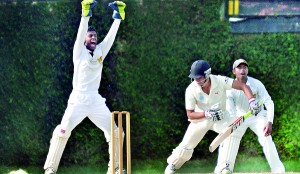From top of cricket mountain, now we see the entire valley
View(s):In this tiny island nation of 20 million people there are four major divides. First it is ethnic, then it is religious, then comes the political divide and the fourth, believe it or not, it is cricket.
The first three divides have evolved with humanity and they have had many phases and faces along the way; but the cricket divide got embedded into our society during the final fifty years of the last millennium and since has grown into epic proportions so much so that sometimes the enmities born out of cricket even override the other three divides.Let the first three divides lay where they are — because they have nothing to do with sports, but the fourth is our bread and butter and we at this end are embroiled in it wholly.

Sri Lanka have to be ready and the time is right to get ready for the kill. - Pic by Amila Gamage
As a result of this divide, cricket has struggled to move forward although the game has reached the pinnacle in world status. As a result of the divide, the Lankan cricket has stood steadfastly holding on to its stubborn stances refusing to change and move with the true international requirements which are vital for the survival at the top as a leading cricket playing nation.
After gaining full voting rights at the world cricket body in 1981 and then going on to win the cricket world cup in 1996, Lankan cricket sailed on course aiming for bigger deeds, but by the beginning of the new millennium the wheels began to turn while the vehicle was on hand breaks and the damage — and the impact that had on the cricket vehicle was destructive.
At one juncture the whole club structure was in the lurch as a result of certain developments that cropped up because of the clubs’ own seeking and then the ensuing interim committees became a nuisance to cricket’s controlling body — the ICC — because of direct political interference. During the last three years, ICC-directed changes have been adopted by the Lankan cricket administration. But as observers from the other side of the fence, we cannot be overly satisfied. The change from the politically controlled interim committees to the present democratically elected cricket managements has not brought a big difference. We only see the leopard has jumped from one hill to the other, but, its inherent spots still remain the same.
That is the broader perspective. At this year’s election something noteworthy also occurred. In spite of the bickering, came an opposition into the same broil and now both sides of the divide are compelled to work towards a common goal and definitely the winner of this sandwich is the game of cricket.
The changes are blooming sporadically. It was just the other day that the Lankan under 17 team beat a fully fledged England team of the same age group by an inning in a game played in England. The Lankan under 23 team is doing well in Singapore at a tournament which is named tagged as the ACC Emerging Teams Cup 2013.
Besides, now the cricket administration has begun to think cohesively and collectively. They have begun to think about the root causes that have held back the growth of the game in the recent past.
 The Lankan cricket think tank has begun an earnest session of soul searching: What could break the current impasse in cricket and how could we move forward, in all segments of the game?
The Lankan cricket think tank has begun an earnest session of soul searching: What could break the current impasse in cricket and how could we move forward, in all segments of the game?
They have begun to discuss an act on the school cricket which has been driven completely out of course by a bunch of school teachers whose ambitions and final goals are quite different from the national interest. Quite appreciatively the think tank members also have started an open dialogue with the Ministry of Education and kept that segment of cricket correctly informed and are trying to harness the maximum benefit of the schools segment of cricket for the national grid.
Now the first ten overs in a game have to be operated by seam bowlers. Maximum number of matches for a school season could be four in the third term and another twelve in the first term. Besides, there are even moves to scrap the inter-school cricket tournament (the biggest bane to teen cricket as far as we are concerned) and re-introduce the good-old friendly matches system.
The longer duration matches are back in vogue. From the next season the accent on four-day cricket in Premier League and Provincial (Finally if they settle down to name it so) will be serious, with the second round of the 14 team Premier League being played as a super tournament which would be lean and mean. Then the Provincial tournament would only comprise 4-5 teams and that tournament would carry the best 75 cricketers in a strong showdown of wits and talent.
SLC’s tournament committee chairman Roshan Iddamalgoda who is well informed about the prevailing situation explained that they were even thinking of managing the wickets from next season so that the wickets would have time to recuperate and provide healthy good wickets through the season. For this, according to Iddamalgoda, the SLC will have about a three-month period void of any cricket so that the curators could infuse new life to the worn and torn surfaces which otherwise would deteriorate further through the year.
Not only in the infrastructure, there will also be changes in the approach to the building of the next breed of cricketers.
Ranjit Fernando who is a part of the think tank as the chairman of the Cricket Development Committee said that even the coaching systems were going to be fast tracked to meet the present needs of international cricket. For instance, he said the younger breed of cricketers would be encouraged to play on the back foot and be comfortable in that discipline. “The coaches would be encouraged to push the young batsmen on to the back foot and this skill will help these youngsters when they grow up to play in fast bouncy tracks in Australia and South Africa.”
Positive thinking and living out of the box by the SLC think tank is encouraging. We see a lot of upgrading which had not been tried or dared has been put into the work ethics.
Now that we have the system in place, it should run. Now it is up to the ‘think tank’ to see what’s working for the local cricket and make them work better. See what areas that need adjustments and effect them expeditiously.
Once again it is encouraging that the ball is rolling. Now what we need is a programme that will pave Sri Lanka into the future and make them not runners-up, but winners. Remember – 2014 — T-20 World Championships in Bangladesh. 2015 — ICC World Cup in Australia and New Zealand. 2017 ICC Test Championships in England. Sri Lanka have to be ready and the time is right to get ready for the kill.
comments powered by Disqus

